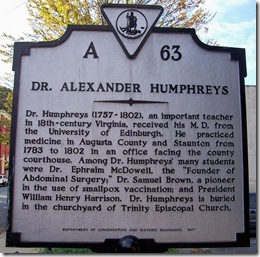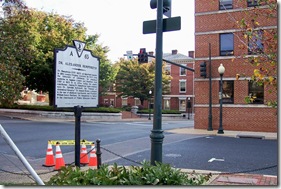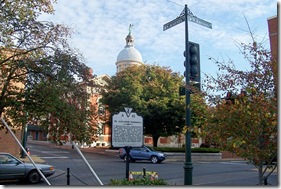 Marker No. A-63
Marker No. A-63
City of Staunton
Augusta County, VA
Marker Text: Dr. Humphreys (1757-1802), an important teacher in 18th-century Virginia, received his M.D. from the University of Edinburgh. He practiced medicine in Augusta County and Staunton from 1783 to 1802 in an office facing the county courthouse. Among Dr. Humphreys' many students were Dr. Ephraim McDowell, the "Founder of Abdominal Surgery;" Dr. Samuel Brown, a pioneer in the use of smallpox vaccination; and President William Henry Harrison. Dr. Humphreys is buried in the churchyard of Trinity Episcopal Church.
Location: Downtown Staunton at intersection with South Augusta Street at West Johnson Street. Erected by the Department of Conservation and Historic Resources in 1987.
In the past few weeks, I have posted markers related to the McDowell family in Rockbridge County, VA and particularly Dr. Ephraim McDowell and his father, Samuel McDowell who became renowned individuals after moving to present-day Danville, KY. Today's marker is related to the medical training of Dr. McDowell, as well as notable other individuals who were trained and mentored by Dr. Alexander Humphreys. Dr. Humphreys’ was a pioneer teaching doctor who left his mark on Staunton, VA and the medical profession by his own medical practice and others he trained, who in turn made their mark on medical history.
 Alexander Humphreys was born in the north of Ireland in 1757. Alexander's first medical training was gained by apprenticing with his uncle. He later traveled to Scotland to further his education by studying at the University of Edinburgh for three years. His graduation at the age of 25 gave him the title of doctor of medicine. Soon after his graduation Dr. Humphreys decided to emigrate to Virginia and join his older brother, David Carlisle Humphreys, who lived near Greenville in Augusta County since 1764. Humphreys lived in the Greenville area from 1783 until 1787, when he decided to move his medical practice to Staunton and became a leading citizen there.
Alexander Humphreys was born in the north of Ireland in 1757. Alexander's first medical training was gained by apprenticing with his uncle. He later traveled to Scotland to further his education by studying at the University of Edinburgh for three years. His graduation at the age of 25 gave him the title of doctor of medicine. Soon after his graduation Dr. Humphreys decided to emigrate to Virginia and join his older brother, David Carlisle Humphreys, who lived near Greenville in Augusta County since 1764. Humphreys lived in the Greenville area from 1783 until 1787, when he decided to move his medical practice to Staunton and became a leading citizen there.
In 1787 Staunton was a small frontier town on the edge of western Virginia in the Shenandoah Valley. In this crossroads town there were about 200 buildings that housed roughly 800 people from all walks of life. Early medical training in the U.S. was often gained by working and being mentored by an existing physician, like Dr. Humphreys and sometimes included formal education at some university.
In Staunton, Humphreys helped organize a fire company, owned a great deal of city real estate, and served on a local school board among other civic duties. He soon petitioned the Staunton court for the right to build an "elaboratory" near the site of the present Augusta County jail. It was here that he performed dissections, had his employee, an apothecary, mixed medicines, and trained a number of students.
Several of the graduates of his "school of medicine" later gained fame in their own practice of medicine and made significant contributions. In 1794, Dr. Jesse Bennett performed an emergency cesarean section on his wife, the first such operation ever performed. Bennett lived in Rockingham County and the surgery was a last-resort effort to save his wife’s life. Both mother and child survived. I have a marker about Dr. Bennett and his surgery which I will post at a later date.
 Another student who gained fame for abdominal surgery was Dr. Ephraim McDowell, later called the “father of abdominal surgery." When Ephraim McDowell was 12, his family moved to Kentucky. Seven years later he returned to Staunton for three years of medical study under Humphreys. From 1793 to 1794 he studied in Scotland both at Edinburgh University and under the guidance of a Scottish doctor. He returned to Staunton briefly in 1794 before going back to Danville, Kentucky where he was an active citizen and a practicing doctor. More details about Dr. McDowell's famous surgery will come later.
Another student who gained fame for abdominal surgery was Dr. Ephraim McDowell, later called the “father of abdominal surgery." When Ephraim McDowell was 12, his family moved to Kentucky. Seven years later he returned to Staunton for three years of medical study under Humphreys. From 1793 to 1794 he studied in Scotland both at Edinburgh University and under the guidance of a Scottish doctor. He returned to Staunton briefly in 1794 before going back to Danville, Kentucky where he was an active citizen and a practicing doctor. More details about Dr. McDowell's famous surgery will come later.
Another famous student was Dr. Samuel Brown born in 1769 in Rockbridge County, Virginia, two years before Dr. Ephraim McDowell who also born in the same county. He received his medical degree in 1794, and in 1797 he moved to Lexington, Kentucky. In 1799 he was named a medical professor at Transylvania University in Lexington, KY. Brown was a leader in his field and was a pioneer in the inoculation of smallpox. Dr. Brown and William Clark, known for the Lewis and Clark Expedition, were members of the same circle and knew each other. Dr. Brown and Thomas Jefferson were friends.
Other famous students from the "elaboratory" were William Wardlaw who became a famous Tennessee doctor and Andrew Kean who became a chief surgeon in the War of 1812. William Henry Harrison, the ninth U.S. president, entertained thoughts of a career in medicine and studied for a while under Dr. Humprey's in Staunton.
Humphreys’ career came to an end with his death in 1802. He was buried in the cemetery at Trinity Episcopal Church. Shortly after his death, his immediate family moved to Kentucky.
No comments:
Post a Comment